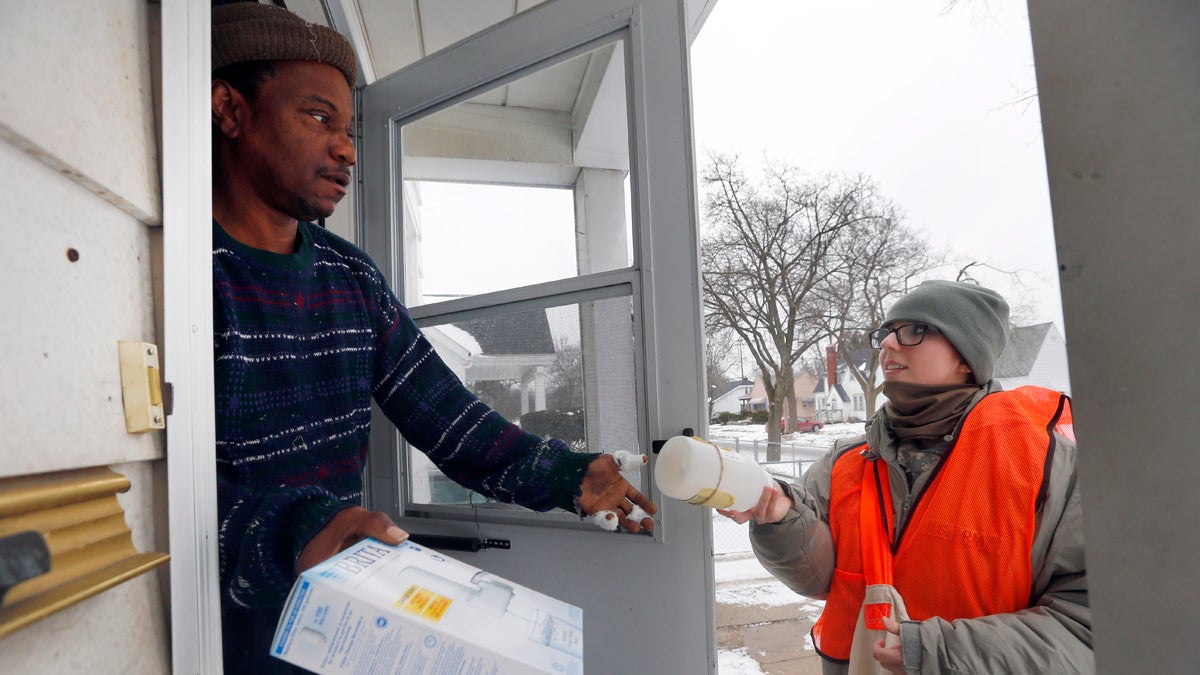Ideas Worth Stealing: Replace all lead pipes

Louis Singleton receives water filters and a test kit from Michigan National Guard Specialist Jelena Tasevska Thursday, Jan. 21, 2016 in Flint, Mich. The National Guard, state employees, local authorities and volunteers have been distributing lead tests, filters and bottled water during the city's water crisis. (AP Photo/Paul Sancya)
Madison, Wisconsin replaced all of the lead service lines in the city through an initiative started in 2001.
Ideas Worth Stealing: Every week, Keystone Crossroads looks to cities across the world for lessons in urbanism and municipal governance that could benefit Pennsylvania. No city does it all right, and we hope these examples from metropolises near and far inspire and encourage cities here to think outside the box.
In the wake of the news coming out of Flint, Michigan — of lead-tainted water poisoning the city’s residents — people in older cities with lead pipes underground have wondered if the same thing can happen in their own towns. While the combination of circumstances in Flint are uncommon, lead pipes are not, and neither are lower levels of contamination. Cities in Pennsylvania have lead service pipes — those are the pipes that run between a water main and a house or apartment building — and in mandatory tests cities like Pittsburgh have documented homes with lead at levels where the Environmental Protection Agency would demand action.
One city where residents are not stressing right now, though, is Madison, Wisconsin.
In 2001, Madison started a program to replace all lead service lines in the city.
The service lines are owned in part by the city and in part by the homeowner, so the city also passed an ordinance requiring homeowners to replace their end of the pipe. Capitol construction funds from the city’s budget covered the publicly owned pipes and the city reimbursed half of homeowners’ expenses, or up to $1,000, for work on the private side. Funds for the latter sections came from fees collected from hosting antennas on water towers and reservoirs. Not counting homeowner’s expenses, the completed project cost $15.5 million and replaced about 8,000 service lines.
Amy Barrilleaux, public information officer for the Madison Water Utility, said when news from Flint started to gain traction, the community felt sad. “Now that people are starting to worry about lead in drinking water I can tell you as a community it’s pretty…happy…they’re pretty proud of what Madison was able to do looking back,” she said.
In 1991, the EPA’s Lead and Copper Rule started requiring water utilities to test water for lead. Madison’s water failed the tests. According to the Rule, Madison had to add anti-corrosive agents to its water to reduce lead levels. But tests with various anti-corrosives did not improve the water quality. The only chemical with the potential to lower lead levels in Madison contained phosphates.
“We’re trying to keep phosphorous out of our lakes and our streams. And so for us that would just mean passing on a huge problem downstream once this water is released back into the environment,” Barrilleaux said. A consultant working with the utility suggested replacing the pipes. “So in Madison we didn’t feel like we had another option,” said Barrilleaux.
Still, it took years to move forward on the controversial proposal. The city started exploring replacement in the 1990s and didn’t pass the ordinance until 2001. “It’s an ordinance, and they’re required to do it, but it’s very difficult to convince people to do it when they know there’s going to be an expense involved,” Barrilleaux said.
She added that cities are now getting in touch with the utility to learn how they were able to pull off such a program, and she’s been scrambling to gather data and documents from the early aughts. “For us, this is so long ago. We’ve considered this program complete for years.”
WHYY is your source for fact-based, in-depth journalism and information. As a nonprofit organization, we rely on financial support from readers like you. Please give today.



